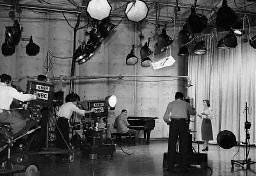|
Sound
> Mikes > Types > Boom &
Fishpole
|

ABOVE: The "furry-thing-on-a-stick"
is a fishpole mike.
BELOW: The long horizontal pole in
the middle of the image is a microphone
boom (the actual mike is at the very
end of the pole)

|
|
|
Both
"boom" and "fishpole"
mikes are supercardioid mikes that are pointed at the
subject from a distance--and thus invisible to the TV
viewer.
A
fishpole is a supercardioid mike attached to a stick;
a boom mike is attached to a much larger apparatus (and
used only in a studio) but the idea is basically the
same.
Again,
the big advantage of a boom or fishpole is that the
mike cannot be seen because it is held slightly off-camera.
This makes these mikes perfect for TV dramas or sitcoms.
In fact, nearly every prime time comedy or drama uses
booms and fishpoles exclusively. So when you see the
doctor flirt with the nurse on your favorite medical
drama (or soap opera!) rest assured that just off camera
a mike operator is pointing a fishpole or boom at the
romantic couple. Booms and fishpoles can gather very
high quality sound, and they free up actors from having
to worry about mike cables and wires.
The
big disadvantage of booms and fishpoles is that you
need a crew person to hold the darn thing. Remember,
a lav mike can be clipped on by the camera operator
before shooting; but a fishpole or boom must
be "pointed" by somebody during the shot. So you have
to have a warm body to operate either a boom or fishpole.
The other disadvantage is cost. Fishpole mikes start
at about $1,000; booms cost much more.
|

A
boom operator (above) manhandles a
microphone boom. His job is to turn
the boom to make sure it points at
the person who is talking. Why am
I using such old photos of sound booms?
These things haven't changed since
the 1930s!

|
|
|
|